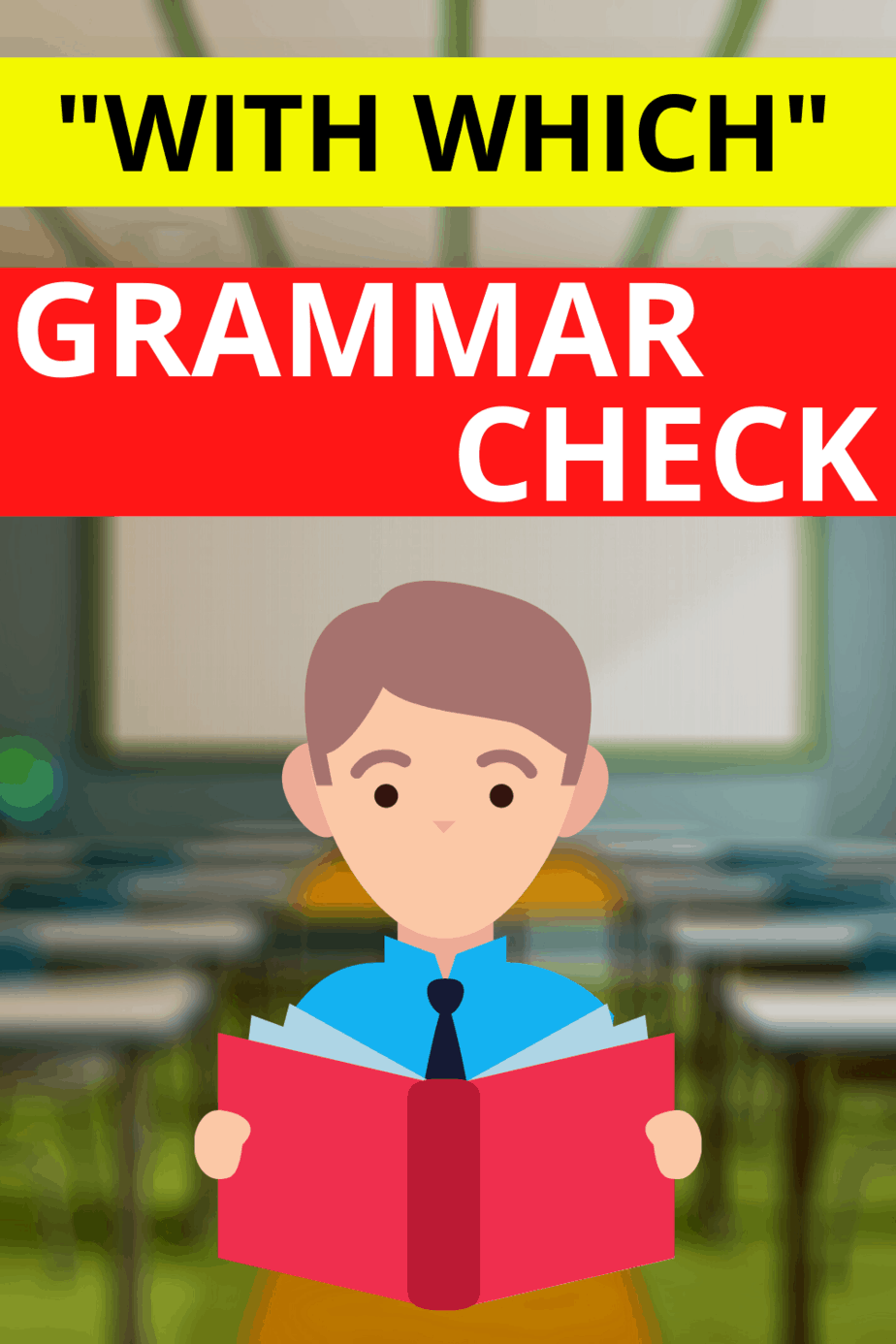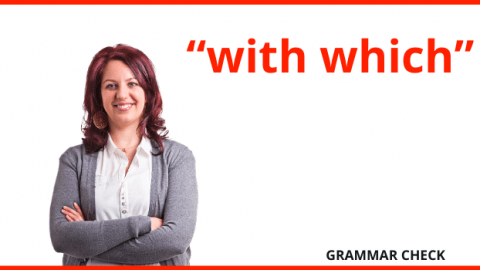For native and non-native English users alike, some expressions could get trickier to use.
This is especially true with prepositions since they may sometimes have multiple meanings.
The preposition with generally functions as an agentive or instrumental indicator for results and end-products.
Adding which, a pronoun, after with creates a slightly more complex denotation which will be elaborated more later.
[toc]
Is “with which” grammatically correct?
Yes, it is a grammatically-correct phrase applicable in all sentence patterns. The expression with which is a combination of a preposition and a pronoun which is used to add extra details to another noun in sentences.
With is more specifically an agentive or instrumental preposition used to indicate accompaniment, possession, manner, harmony, or exception.
Whereas, which is a relative pronoun that could be used to replace or represent objects or abstract concepts.
Relative pronouns are used to refer to previously-mentioned nouns, and they also introduce phrases or clauses that further define nouns in the sentence.
Generally, with which can be used in all sentence patterns to refer back to another noun to avoid lexical redundancy.
In which types of sentences can we use “with which?”
There are four sentence variations according to forms: simple, compound, complex, and compound-complex sentences.
A simple sentence, also called an independent clause, contains at least one subject and one verb which forms a complete thought.
It does not contain any coordinating conjunctions that connect another independent clause nor any subordinate or correlative conjunctions that link a dependent clause.
Compound sentences are composed of at least two independent clauses that can stand separately.
They are connected by coordinating conjunctions, a.k.a the FANBOYS, such as and, or, and but.
Whereas, sentences composed of one independent clause and a minimum of one dependent clause fall under the complex type.
Complex sentences are conjoined by subordinate and correlative conjunctions like although, unless, no only…but also, and neither…nor.
Lastly, compound-complex sentences are made up of one or more independent clauses and one or more dependent clauses.
This type of sentence utilizes both subordinating and coordinating conjunctions, which may also be replaced by semicolons.
Simple Sentence
In sentence construction, a simple sentence typically refers to short sentential patterns having at least one subject and one predicate.
It may also be alternatively called an independent clause.
A simple sentence can be as short as a two-word structure that can be ended with a terminal punctuation mark.
Despite being vividly brief, each sentence above illustrates a complete thought that can be understood by a reader.
However, it can also be constructed at length for as long as no additional independent or subordinate clause is added.
This means that it can have multiple subjects or multiple verbs, altogether with complementary elements.
Andrew and Anna are fraternal twins with emerald-green eyes.
I can read and drive at the same time. (Not!)
Despite the possibility, English language teachers would avoid this kind of expression in explaining the idea of simple sentences to prevent misinterpretation and overanalysis.
In the simple sentence above, the word bat is the object of the instrumental preposition with.
Taken as a prepositional phrase, with the bat functions as an adverbial adjunct (which is grammatically-removable) that is added to supplement the meaning of the sentence.
Furthermore, all the words after bat are intentionally added to provide a more specific definition of the word bat.
Do you now see what I meant when I explained earlier why teachers avoid this type of quite complicated pattern?
Put simply, no matter how long the sentence above looks, it is still considered as a simple sentence for having only one subject and one verb with some complementary components.
The last example further demonstrates one crucial quality of the English language which is recursion.
Recursion is the sequential repeatability of language patterns that entails the human ability to generate sentences exponentially, thereby allowing complex communication processes.

Compound Sentence
A compound sentence, once again, is formed by combining two or more independent clauses with coordinating conjunctions.
Coordinating conjunctions are mnemonically known as the FANBOYS (i.e., for, and, nor, but, or, yet, so).
Compounded sentences necessitate a comma before the coordinating conjunction to mark the clausal segregation.
The Akkadians immigrated to Mesopotamia in 2300 BC, and their empire ruled the region for two centuries.
Looking at the sentence above, we can deduce that a compound sentence is a sum of combining two simple sentences linked by the conjunction and.
With which, may also be used in this sentence pattern such as in the next example.
Although the sentence above is a bit of a mouthful, it is only a compound sentence with two complete thoughts and extra definition.
The preposition with acts as an instrumental indicator of bilingualism which positively affected the cultural relationship in Mesopotamia.
Which also refers back to bilingualism, and all the words that come after which syntactically define the idea of the combination of two languages.
Thus, the phrase with which and all other additional words refer back to the noun, bilingualism, and function as an adjective in the sentence.
Complex Sentence
A complex sentence is a mixture of one independent clause and one or more subordinate clauses that are attached by either a subordinating or correlative conjunction.
The most common subordinating conjunctions are although, even if, unless, and if.
Correlative conjunctions are linking words that come in pairs.
The most commonly used correlative conjunctions are not only…but also, either…or, neither…nor, and both…and.
Furthermore, the dependent clause or clauses in a complex sentence may be a noun clause, adjective clause, or an adverbial clause.
Being able to create complex sentences in text entails an individual’s written literacy in constructing and arranging clauses with varying amounts of emphasis.
Now, let’s apply the with which phrase in a complex sentence.
Similar to the examples in simple and compound sentences, all lexical constituents after with which are used to modify the word caterpillar.
Compound-complex Sentence
As the term implies, a compound-complex sentence is a combination of compound and complex sentences.
The quick and easy way to identify this sentence pattern is to look for at least one coordinating conjunction and one subordinating conjunction in the sentence.
Here’s an example to illustrate the definition above.
As you can see, the sentence starts with a dependent clause introduced by the subordinating conjunction because.
Then, it is followed by two independent clauses, with the second independent clause introduced by the coordinating conjunction and.
Now, let’s use the with which phrase to reconstruct the sentence.
Which is the object of the preposition with that introduces a nonessential relative clause which refers back to Nirvana’s albums.
We may also omit the coordinating conjunction in the last independent clause and attach it with a semicolon instead.
Looking at the compound-complex sentence format, we can understand that it essentially is just a multiplex combination of several sentence forms.
Despite the possibility of this type of construction, it has to be used sparingly.
Even though the ability to build this multifaceted sentential pattern entails language literacy, it may also unintentionally produce confusion to some.
Less advanced language learners and non-technical readers could misunderstand or get overwhelmed, which is counter-productive.
Ergo, the intended audience must also be considered when constructing sentences.
Conclusion
Sentence construction generally starts at easy patterns such as in two-word simple sentences.
On the other side of the coin, it could also become strenuous, especially in more complicated structures.
Getting tripped in studying English more technically, as in syntax, is not rare.
However, being able to recognize feelings of anxiety towards learning sentence patterns also means that one’s language competency is meanwhile improving.
We, therefore, have to pat our backs when we start getting more interested, albeit more perplexed as well, in understanding complex language patterns.

Hey fellow Linguaholics! It’s me, Marcel. I am the proud owner of linguaholic.com. Languages have always been my passion and I have studied Linguistics, Computational Linguistics and Sinology at the University of Zurich. It is my utmost pleasure to share with all of you guys what I know about languages and linguistics in general.

